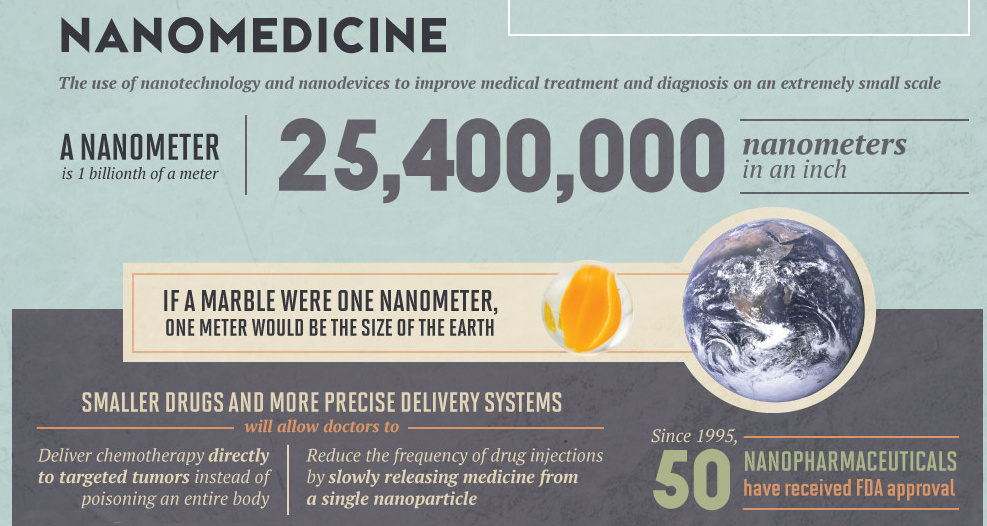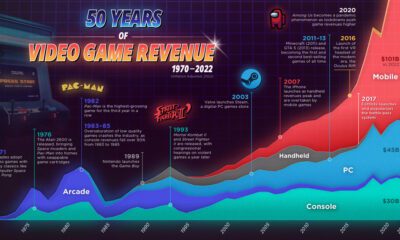Technology
5 Ways Technology is Transforming the Healthcare Industry

5 Ways Tech is Transforming the Healthcare Industry
Whether it’s information-sharing between patients and doctors or aiding in a high-risk surgery, it’s clear that dynamic applications of technology are well underway in disrupting the healthcare industry.
TECH AT OUR FINGERTIPS
Today’s infographic from the Online Medical Care highlights healthcare areas where tech is breaking barriers. Here are five ways that technology is impacting the sector, ranging from AI to nanomedicine:
Artificial Intelligence
Artificial intelligence will have a dramatic impact on many industries, and healthcare is no exception.
A large share of healthcare executives are already applying artificial intelligence in their operations, with data showing plans to increase budgets last year.
| Healthcare uses of AI | Adoption (2017) | Adoption (2018E) |
|---|---|---|
| Clinical decision support | 46% | 59% |
| Population health | 33% | 46% |
| Disease management | 29% | 42% |
| Re-admissions | 33% | 41% |
| Medical costs / health plan | 21% | 38% |
| Patient safety and quality | 25% | 33% |
| Supply chain management | 13% | 21% |
| Cancer care | 4% | 12% |
As the technology becomes more developed and widespread, it’s expected that AI could help diagnose strokes, eye disease, heart disease, skin cancer, and other conditions.
Virtual Healthcare
Also known as telehealth or telemedicine, virtual healthcare allows patients and doctors to touch base remotely using technology such as video conferencing or mobile apps. Many patients are also becoming comfortable using wearable technology to monitor any changes in their health – and sharing that data with their physicians.
Convenience, ease of use, and travel times to their closest doctor are main reasons why patients choose virtual care. On the flip side, many are concerned about the quality of care, or fear a loss of a personal connection with a doctor.
If all patients chose virtual healthcare over face-to-face visits, it could save the U.S. health system $7 billion annually – while the time savings would “free up” the equivalent of 37,000 doctors.
Nanomedicine
Nanomedicine is rapidly evolving field which controls individual atoms and molecules at the extremely minute “nanoscale” of 1 to 100 nanometers. To put that into perspective, a single newspaper sheet is about 100,000 nm thick.
Nanomedicine is mainly used to effectively diagnose, treat, and prevent various diseases. Compared to conventional medicines, it’s much better at precise targeting and delivery systems, paving the way towards combating complex conditions such as cancer.
The global nanomedicine market could be worth over $350 billion by 2025.
Virtual Reality
Although it’s normally been associated with entertainment, virtual reality is making waves in healthcare as well. The multi-sensory, immersive experience that VR provides can benefit both physicians and patients:
- Healthcare worker training
VR can be used to train surgeons in a realistic and low-risk simulated environment. - Physical and mental health
VR offers therapeutic potential and rehabilitation for acute pain and anxiety disorders.
VR is thus considered a cost-effective and efficient tool for both teaching and treatment, and the VR healthcare services market is expected to grow from $8.9 million in 2017 to an expected $285 million in 2022.
3D Printing
3D printing has come a long way since its debut, especially in its uses in the healthcare industry. The technology offers faster prototypes, creating everything from personalized prosthetics to “poly-pills” at a fraction of the cost.
The customizable aspect of 3D printing is revolutionizing organ transplants and tissue repair, and it’s even able to produce realistic skin for burn victims.
Robot-Assisted Surgery
Last but certainly not least, robotic surgery is sweeping through hospitals. It allows doctors to perform delicate and complex procedures that might be otherwise impossible.
Typically, surgeons control a device with a camera and mechanical arms, giving them a high-def view of the surgical site. According to the Mayo Clinic, this method generally:
- Enhances precision, flexibility, and control
- Comes with fewer complications such as infections
- Results in less obvious scars as it is minimally invasive
While technological adoption into the medical field doesn’t come without challenges, the value is clear – and we’ve barely scratched the surface of tech-driven possibilities in the healthcare industry.
Technology
Ranked: Semiconductor Companies by Industry Revenue Share
Nvidia is coming for Intel’s crown. Samsung is losing ground. AI is transforming the space. We break down revenue for semiconductor companies.
Semiconductor Companies by Industry Revenue Share
This was originally posted on our Voronoi app. Download the app for free on Apple or Android and discover incredible data-driven charts from a variety of trusted sources.
Did you know that some computer chips are now retailing for the price of a new BMW?
As computers invade nearly every sphere of life, so too have the chips that power them, raising the revenues of the businesses dedicated to designing them.
But how did various chipmakers measure against each other last year?
We rank the biggest semiconductor companies by their percentage share of the industry’s revenues in 2023, using data from Omdia research.
Which Chip Company Made the Most Money in 2023?
Market leader and industry-defining veteran Intel still holds the crown for the most revenue in the sector, crossing $50 billion in 2023, or 10% of the broader industry’s topline.
All is not well at Intel, however, with the company’s stock price down over 20% year-to-date after it revealed billion-dollar losses in its foundry business.
| Rank | Company | 2023 Revenue | % of Industry Revenue |
|---|---|---|---|
| 1 | Intel | $51B | 9.4% |
| 2 | NVIDIA | $49B | 9.0% |
| 3 | Samsung Electronics | $44B | 8.1% |
| 4 | Qualcomm | $31B | 5.7% |
| 5 | Broadcom | $28B | 5.2% |
| 6 | SK Hynix | $24B | 4.4% |
| 7 | AMD | $22B | 4.1% |
| 8 | Apple | $19B | 3.4% |
| 9 | Infineon Tech | $17B | 3.2% |
| 10 | STMicroelectronics | $17B | 3.2% |
| 11 | Texas Instruments | $17B | 3.1% |
| 12 | Micron Technology | $16B | 2.9% |
| 13 | MediaTek | $14B | 2.6% |
| 14 | NXP | $13B | 2.4% |
| 15 | Analog Devices | $12B | 2.2% |
| 16 | Renesas Electronics Corporation | $11B | 1.9% |
| 17 | Sony Semiconductor Solutions Corporation | $10B | 1.9% |
| 18 | Microchip Technology | $8B | 1.5% |
| 19 | Onsemi | $8B | 1.4% |
| 20 | KIOXIA Corporation | $7B | 1.3% |
| N/A | Others | $126B | 23.2% |
| N/A | Total | $545B | 100% |
Note: Figures are rounded. Totals and percentages may not sum to 100.
Meanwhile, Nvidia is very close to overtaking Intel, after declaring $49 billion of topline revenue for 2023. This is more than double its 2022 revenue ($21 billion), increasing its share of industry revenues to 9%.
Nvidia’s meteoric rise has gotten a huge thumbs-up from investors. It became a trillion dollar stock last year, and broke the single-day gain record for market capitalization this year.
Other chipmakers haven’t been as successful. Out of the top 20 semiconductor companies by revenue, 12 did not match their 2022 revenues, including big names like Intel, Samsung, and AMD.
The Many Different Types of Chipmakers
All of these companies may belong to the same industry, but they don’t focus on the same niche.
According to Investopedia, there are four major types of chips, depending on their functionality: microprocessors, memory chips, standard chips, and complex systems on a chip.
Nvidia’s core business was once GPUs for computers (graphics processing units), but in recent years this has drastically shifted towards microprocessors for analytics and AI.
These specialized chips seem to be where the majority of growth is occurring within the sector. For example, companies that are largely in the memory segment—Samsung, SK Hynix, and Micron Technology—saw peak revenues in the mid-2010s.
-

 Real Estate2 weeks ago
Real Estate2 weeks agoVisualizing America’s Shortage of Affordable Homes
-

 Technology1 week ago
Technology1 week agoRanked: Semiconductor Companies by Industry Revenue Share
-

 Money1 week ago
Money1 week agoWhich States Have the Highest Minimum Wage in America?
-

 Real Estate1 week ago
Real Estate1 week agoRanked: The Most Valuable Housing Markets in America
-

 Business2 weeks ago
Business2 weeks agoCharted: Big Four Market Share by S&P 500 Audits
-

 AI2 weeks ago
AI2 weeks agoThe Stock Performance of U.S. Chipmakers So Far in 2024
-

 Misc2 weeks ago
Misc2 weeks agoAlmost Every EV Stock is Down After Q1 2024
-

 Money2 weeks ago
Money2 weeks agoWhere Does One U.S. Tax Dollar Go?














